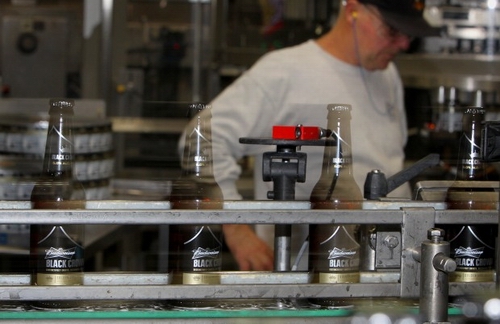
As millions tune in Sunday to Super Bowl XLVII for both the game and the commercials, they’ll see the latest effort by Anheuser-Busch to inject energy into Budweiser beer.
The brand’s U.S. sales volume has been falling since the 1980s, but Budweiser sales are growing outside the U.S., and it remains among the top-selling beers.
Domestic Budweiser shipments fell 5.6 percent in 2012, according to new estimates released this week by trade publication Beer Marketer’s Insights. Bud shipments in the U.S. dropped to 16.7 million barrels last year, eroding its market share to 7.8 percent from 8.4 percent.
Over the long term, the King of Beers’ decline is even more dramatic. Budweiser domestic shipments — which peaked in 1988 — have fallen 29.2 percent since 2007, when it shipped 23.6 million barrels, according to BMI.
Most other leading U.S. beer brands also saw their market shares chipped away last year by craft brands and changing consumer tastes.
The St. Louis-based brewer, the U.S. unit of Belgium-based Anheuser-Busch InBev, is taking steps to stem the decline, and its Super Bowl ads are part of those efforts. A-B bought 4½ minutes during Sunday’s pro football championship, spending between $3.5 million and $4 million per 30-second spot according to industry estimates.
One Budweiser ad, which features the relationship between a newborn Clydesdale and its trainer, asks viewers to name a foal born in January. The Clydesdales have appeared in 23 Super Bowl spots since 1986, and the ad is designed to emphasize the heritage of the 137-year-old Budweiser brand.
A-B used social media to get an early start on the Clydesdale naming promotion, and Budweiser posted its first message on Twitter on Sunday with a photo of the foal. The brewery has received thousands of suggestions, including Hops and Buddakup, on Twitter and Facebook.
“We’re not forgetting about the core” Budweiser customer, said Budweiser brand Vice President Rob McCarthy, adding that Bud’s heritage remains an important part of its marketing.
The Super Bowl ads will also feature a new offshoot of Budweiser, Budweiser Black Crown, which debuted this year.
In an interview Wednesday, McCarthy declined to comment on 2012 full-year sales until parent A-B InBev, the world’s largest brewer, releases earnings later this month. He said A-B is continuing to focus on several strategies, including sports sponsorships and music, to grow Budweiser in the U.S.
“Unquestionably, the success of Budweiser is critical to our U.S. business,” McCarthy said. “It’s not only the heart and soul of the brewery but it’s also a big part of our sales.”
For 2013, A-B will once again hold a music festival similar to last September’s Made In America festival, which was in Philadelphia and featured Jay-Z as a headliner. The location and details of the 2013 event are still being ironed out, but it will be a way to connect with 21- to 27-year-olds who have yet to try a Budweiser, McCarthy said.
“The things that we have been doing, including the Made in America event, we know are resonating with (that age group),” McCarthy said.
Also new for this year, A-B will make Budweiser available in a bow-tie shaped can that reflects the brand’s well-known logo. The new cans will complement the traditional Bud can, which underwent a redesign in 2010.
Top brands suffer
Of the top 10 selling beers in the U.S., BMI estimates that only three saw an increase in shipments in 2012: Coors Light, Corona Extra and Busch Light. A-B, which owns Busch Light, is seeking to buy the remaining half of Corona’s Mexico City-based owner, Grupo Modelo, that it doesn’t already own, but the Justice Department challenged that deal Thursday.
In addition to Budweiser, the other top-10-selling beers in the U.S. that saw declines in 2012 were Bud Light, Miller Lite, Natural Light, Busch, High Life and Keystone Light.
Combined, the top 10 largest brands garnered 59 percent of the market, down from 65 percent a decade ago, according to BMI.
Eric Shepard, executive director of BMI, said craft beers and new brands — including Bud Light Platinum, which A-B launched last year — have cut into the megabrands’ volumes.
“There was a little bit more cannibalization of Bud than the year before from new beers,” Shepard said. “Consumers are trying and drinking other brands.”
Shepard said A-B should continue to focus on those who have never tried Budweiser before. “If they could reach those beer drinkers, it would help.”





